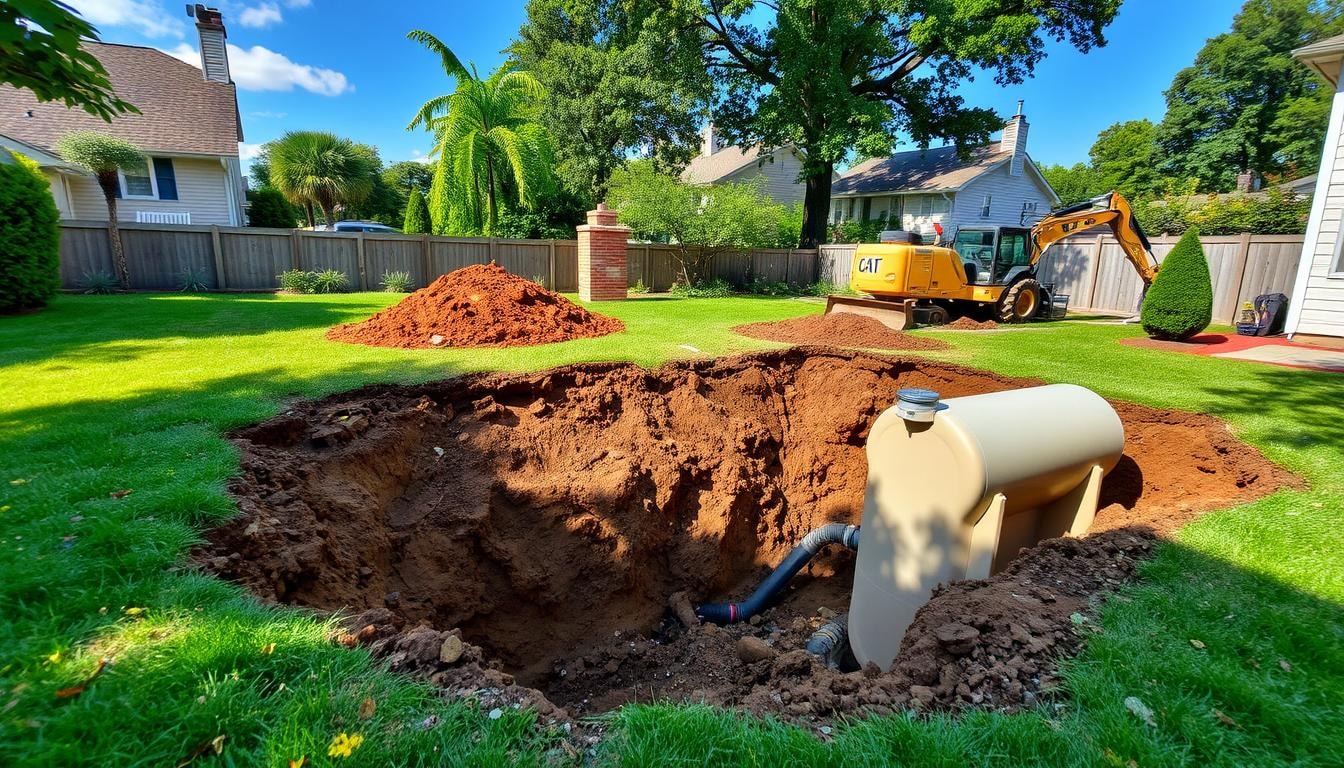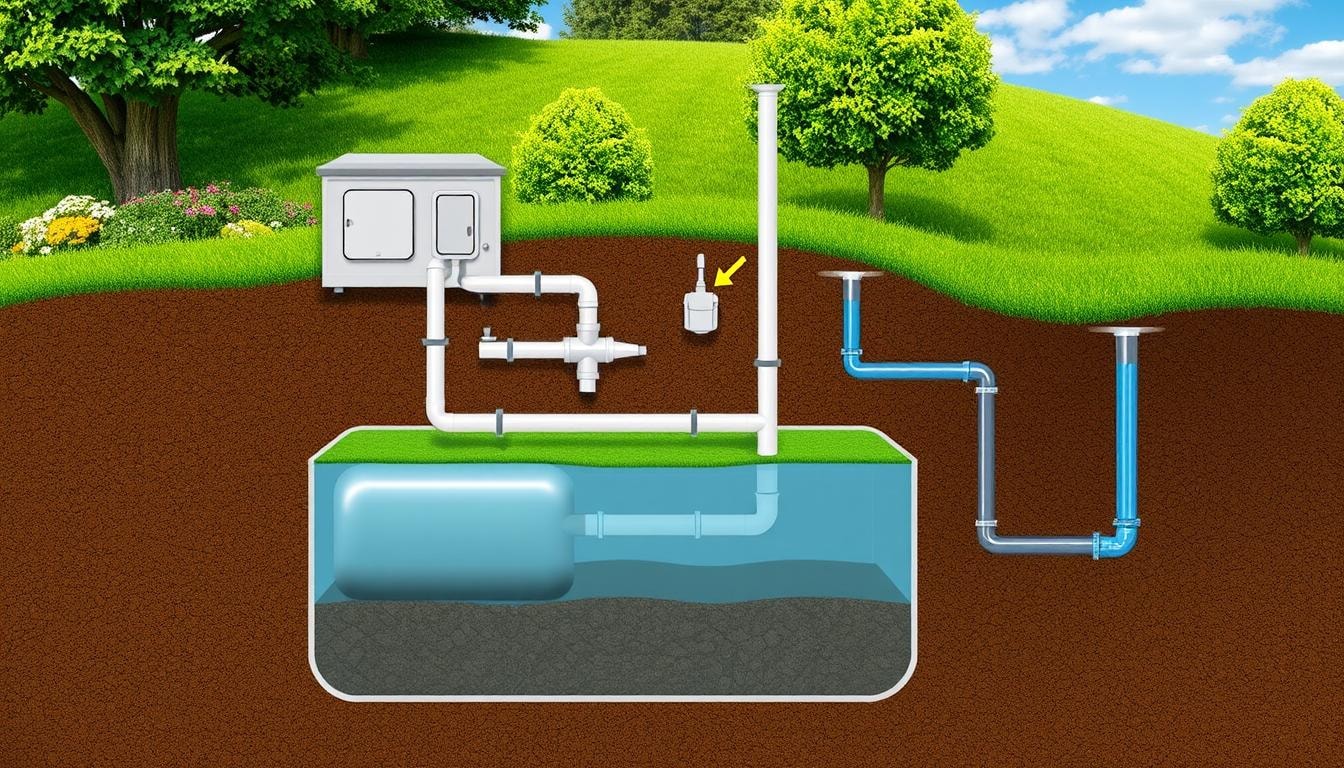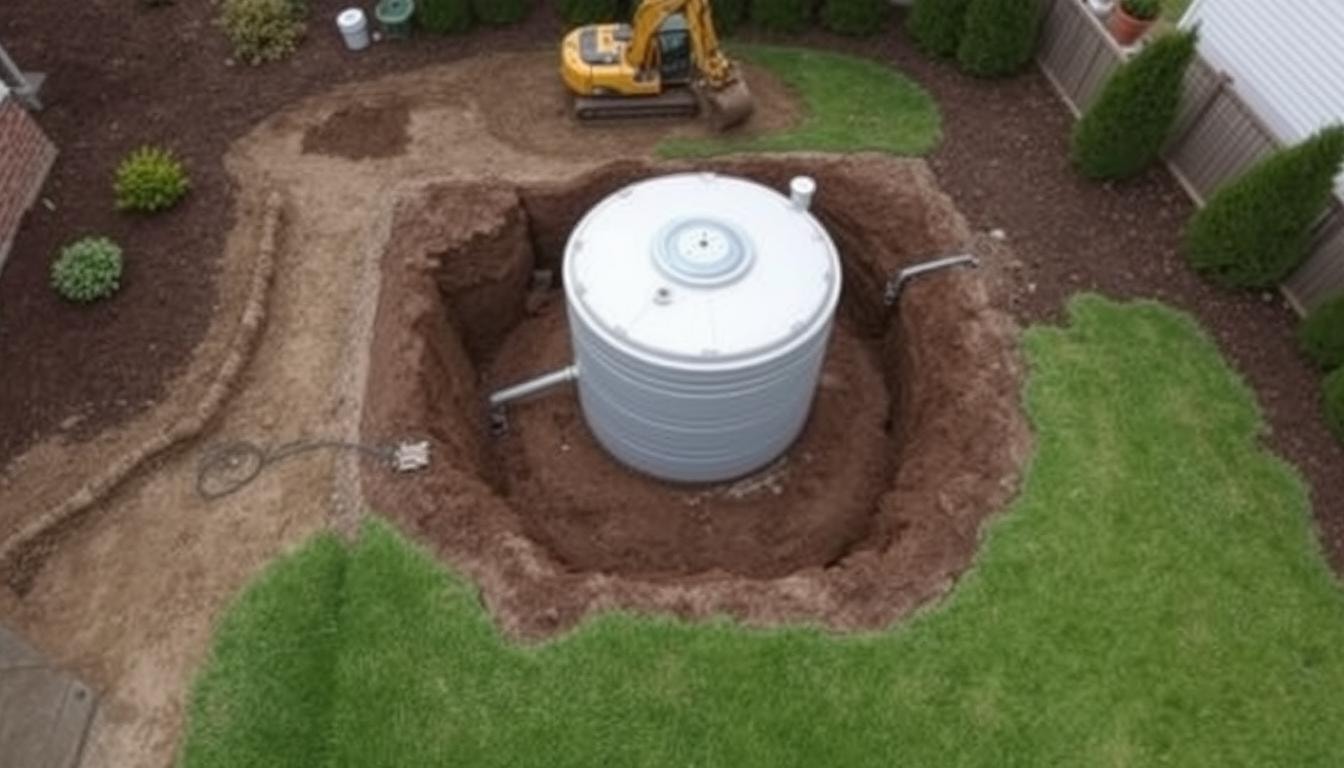Septic Tank Installation Near You
Can’t find what you are looking for?
How It Works
-
Answer a few questions about your home project.
-
Within seconds, get matched with top-rated local pros.
-
Compare quotes and choose the best pro for the job.
Septic Tank Installation In Your Area
Septic Tank Installation: A Guide for Homeowners
Meta Description: Learn everything about septic tank installation, from costs and types to regulations and maintenance. Essential guide for homeowners considering a new septic system.

Curious about septic system installation? It’s a vital step for effective home wastewater management. Let’s explore the key steps and best practices for this complex process.
This guide will help you understand the essentials of septic tank installation. You’ll learn what to consider and how to ensure a successful setup.
Key Takeaways
- Septic systems require regular maintenance, including inspection and pumping every 3-5 years.
- Concrete, fiberglass, and plastic tanks each have their own advantages and disadvantages for installation.
- Site evaluation, including soil analysis and setback requirements, is critical for a successful septic system installation.
- Obtaining the necessary permits and following local regulations is a crucial first step in the installation process.
- Proper installation techniques, such as excavation and safety measures, are essential to avoid issues down the line.
Understanding Septic Systems
Septic systems treat wastewater in homes without municipal sewer connections. They handle water from sinks, toilets, showers, and washing machines. A typical system includes a septic tank and drain field.
Components of a Septic System
The septic tank is a large, underground container made of concrete, fiberglass, or plastic. It separates solid waste from liquid waste. Solid waste settles at the bottom, while liquid waste flows into the drain field.
Advantages and Disadvantages of Septic Systems
Septic systems offer cost-effective wastewater treatment, especially in rural areas. They can be customized to fit specific property needs. However, these systems require regular maintenance to function properly.
Soil conditions can impact system performance. Homeowners may need permits and inspections before installation. Regular pumping and inspections are necessary for optimal functioning.
Understanding septic systems is vital for homeowners considering this wastewater solution. Regular upkeep and following local rules ensure long-term efficiency. Proper care keeps these systems working well for years.
Site Evaluation
A thorough site evaluation is crucial before installing a septic tank. It helps identify the best location for the system. This process analyzes soil, topography, and the surrounding area.
Soil Analysis: The Foundation for Success
Soil analysis is the first step in site evaluation. Experts examine soil type, texture, structure, and consistency. These factors affect wastewater absorption and filtration rates.
The analysis also spots limiting conditions like high water tables. This data helps size the septic system correctly. Proper sizing ensures effective wastewater treatment.
Topography and Setbacks: Ensuring Compliance and Safety
Experts evaluate the site’s topography to find the best elevation. The septic system should be higher than the surrounding area. This prevents contamination of the environment.
Setbacks are also carefully assessed. These are minimum distances between the system and other structures. Proper setbacks ensure compliance with local laws.
Proposed Elevations: Optimizing System Function
Proposed elevations are based on soil and topography evaluations. These elevations are vital for the system’s intended function. They help treat wastewater effectively and prevent environmental issues.
A thorough site evaluation identifies the best septic system location. It ensures long-term efficiency and compliance with local rules. This approach can prevent future environmental and financial problems.
Permits and Regulations
Installing a septic tank requires proper permits and compliance with regulations. These can differ based on your location. Check with your local health or building department for specific standards.
Key permits and regulations include:
- Septic system permit: Homeowners will need to obtain a permit from the local authorities to install a new septic system or make significant repairs to an existing one.
- Zoning and land use regulations: The proposed septic system must comply with local zoning laws and land use regulations, which may dictate the size, location, and type of system allowed.
- Environmental regulations: Septic systems may be subject to environmental regulations, particularly if the property is located near sensitive areas like wetlands or water bodies.
- Construction regulations: The septic system installation must adhere to building codes and construction standards, including safety measures and proper excavation.
- Inspection and maintenance regulations: Regular inspections and maintenance of the septic system may be required to ensure continued compliance and proper functioning.
Not following the rules can lead to fines and legal problems. Research local requirements before starting your septic tank project.
Understanding these rules helps ensure a smooth installation process. It also keeps you on the right side of the law.
Choosing the Right Septic Tank
Selecting the perfect septic tank involves considering several key factors. The tank’s size and construction materials are crucial aspects to think about.
Tank Size
Your septic tank size depends on your household size and daily water use. It should hold at least two days’ worth of wastewater.
Single-family homes typically need a 750 to 1000-gallon tank. Multi-family properties may require 250 gallons per bedroom.
Local regulations and soil conditions affect tank size requirements. Consult local authorities and septic professionals for proper sizing.
Tank Materials
- Concrete: Durable and long-lasting, but heavy and difficult to install.
- Fiberglass: Lightweight and easy to install, but can be more expensive.
- Plastic: Affordable and lightweight, but may not be as durable as other materials and can be prone to cracking.
Each material has unique pros and cons for durability, installation, and cost. Consider your specific needs when choosing the right septic tank material.
Installation Preparation
Homeowners must take crucial steps before installing a septic tank. Excavation is the first step, creating space for the tank and drain field. The location must be identified, often with help from local health departments.
Necessary permits may be required from local government before starting. Homeowners must clear the area of obstacles like rocks and trees. This ensures a smooth installation process.
Heavy machinery like backhoes are often needed for excavation. Safety measures must be followed when using such equipment. Homeowners should be aware of these safety requirements.
Safety Measures
Safety is paramount during septic tank installation. Following OSHA regulations ensures worker safety throughout the process. The site must be secured to prevent unauthorized access.
Identifying underground utilities is crucial to avoid accidents. These safety precautions are vital for a successful installation. They help prevent mishaps and ensure efficiency.
- Comply with OSHA regulations for worker safety
- Secure the site to prevent unauthorized access
- Identify and avoid any underground utilities
These steps ensure a safe and successful septic tank installation. They minimize risks and maximize efficiency. Proper preparation leads to a smooth installation process.
Types of Septic Systems

Homeowners can choose between conventional and alternative septic systems. Conventional systems use natural wastewater flow through a septic tank and drain field. The soil then further treats the partially treated wastewater.
Conventional Septic Systems
Gravity and pressure systems are two types of conventional septic systems. Gravity systems rely on natural forces to move wastewater. Pressure systems use pumps to distribute wastewater throughout the system.
Alternative Septic Systems
Alternative systems are used when soil conditions aren’t suitable for conventional systems. They may also be used in areas with too many systems. These systems use new technology to improve treatment processes.
Some alternative systems use sand, peat, or plastic media instead of soil. Others may use wetlands, lagoons, aerators, or disinfection devices. These systems often have electrical or mechanical parts requiring yearly inspection.
About 20% to 30% of American households use septic systems. In some states, over 40% of residents rely on septic tanks. The Gravity Fed Septic System is the most common type.
Alternative systems are becoming popular for challenging soil conditions. These include Chamber, Mound, Recirculating Sand Filter, and Aerobic Treatment Unit systems. They offer cost-effective and efficient options for homeowners with limited space.
Maintenance and Inspection
Proper maintenance is vital for a septic system’s long-term function. Professionals should inspect it every 3 years. Tank pumping is recommended every 3 to 5 years.
Household size, water usage, and tank levels affect pumping frequency. Regular care can extend system life and prevent costly repairs.
Regular Pumping
Service providers check for leaks and measure tank levels during inspections. They determine if pumping is needed. Homeowners should keep records to plan future services.
Inspections
- In addition to regular pumping, homeowners should also have their septic systems inspected regularly, at least every 3 years.
- During an inspection, the service provider will locate the septic system, uncover the access holes, check for signs of backup, measure the sludge and scum levels, and inspect any mechanical or electrical components.
- Regular inspections help ensure that the septic system is functioning properly and can identify any issues before they become major problems.
- Inspections of septic systems are often necessary when buying or selling a house to ensure the system is in good working order.
A regular maintenance schedule helps ensure septic system health. Inspections identify issues early. This approach keeps the system running efficiently for years.
Cost Considerations
The cost of installing a septic system varies based on several factors. Material costs for the tank itself play a crucial role. Concrete tanks are usually the cheapest, ranging from $700 to $2,000.
Fiberglass and plastic tanks are more durable but pricier, costing $1,200 to $2,500. Steel tanks are less common and generally more expensive.
The size of the septic system also affects material costs. Larger tanks for 5-6 bedroom homes can cost $1,200 to $2,500. Smaller systems for 1-2 bedrooms may range from $500 to $1,200.
Labor Costs
Labor costs for septic system installation are significant, often 50-70% of the total project cost. These costs vary by location, installation complexity, and site requirements. Homeowners typically pay $1,500 to $4,000 for labor.
Landscaping work and site accessibility can also impact labor costs. Budget $2,000 to $5,000 or more for a complete new septic system installation. Specialized or engineered systems may cost even more.
Tips for Hiring the Best Septic Tank Installation Professionals

Hiring skilled septic tank installation professionals is vital for your system’s success. Seek licensed contractors who know local permits and regulations. They should excel in site evaluation and proper installation.
Here are some tips to find the right experts:
- Check the contractor’s local expertise in your area. This ensures they know your location’s specific needs.
- Read customer reviews and check the Better Business Bureau. This helps gauge their reputation and work quality.
- Verify that licensed contractors know current regulations and permit requirements. This is crucial for legal compliance.
- Ask about the company’s credentials, insurance, and warranties. These protect your investment in the long run.
- Get quotes from multiple providers. This helps you find the best value for your installation needs.
The right professionals ensure your septic system works well for years. They’ll install it correctly, giving you peace of mind.
Finding the Right Pros for Your Septic Project
If you’re considering a new septic tank system, replacement, or any other septic project, FindPros can help. Quickly answer a few questions about your home and septic needs, such as the type of system (conventional, chamber, aerobic, or mound), soil conditions, water table, and any special requirements from your local health inspector or government.
Within seconds, FindPros will match you with top-rated local professionals who can provide accurate quotes, factoring in labor costs, installation expenses, and landscaping as needed. Save money by letting pros compete for your business, and find the right septic expert you feel most comfortable working with, whether it’s for a steel, concrete, or plastic septic tank. Take the stress out of your septic project and let FindPros handle the hard work of finding the perfect pros for the job.
Conclusion
Septic tank installation needs careful planning and compliance with local rules. Homeowners must understand septic system parts, installation steps, and maintenance needs. Choosing the right septic tank and hiring experts ensures successful installation.
Proper maintenance of your septic system protects your investment and the environment. It also keeps your household safe. With care, homeowners can install a septic tank confidently.
Success comes from knowing your property’s needs and local regulations. Working with skilled professionals is key. This approach ensures your septic system works well for years.
A well-installed system reduces repair costs and environmental impact. It provides a lasting solution for managing wastewater. By following these steps, you’ll have an efficient septic system.
Frequently Asked Questions (Septic Tank Installation)
MOST POPULAR CITIES
Browse by State- Alameda
- Costa Mesa
- Laguna Beach
- Orange
- Alhambra
- Culver City
- Lancaster
- Oroville
- Anaheim
- Daly City
- Livermore
- Oxnard
- Antioch
- Davis
- Lodi
- Pacific Grove
- Arcadia
- Downey
- Lompoc
- Palm Springs
- Bakersfield
- El Centro
- Long Beach
- Palmdale
- Barstow
- El Cerrito
- Los Angeles
- Palo Alto
- Belmont
- El Monte
- Malibu
- Pasadena
- Berkeley
- Escondido
- Martinez
- Petaluma
- Beverly Hills
- Eureka
- Marysville
- Pomona
- Brea
- Fairfield
- Menlo Park
- Port Hueneme
- Buena Park
- Fontana
- Merced
- Rancho Cucamonga
- Burbank
- Fremont
- Modesto
- Red Bluff
- Calexico
- Fresno
- Monterey
- Redding
- Calistoga
- Fullerton
- Mountain View
- Redlands
- Carlsbad
- Garden Grove
- Napa
- Redondo Beach
- Carmel
- Glendale
- Needles
- Redwood City
- Chico
- Hayward
- Newport Beach
- Richmond
- Chula Vista
- Hollywood
- Norwalk
- Riverside
- Claremont
- Huntington Beach
- Novato
- Roseville
- Compton
- Indio
- Oakland
- Sacramento
- Concord
- Inglewood
- Oceanside
- Salinas
- Corona
- Irvine
- Ojai
- San Bernardino
- Coronado
- La Habra
- Ontario
- San Clemente